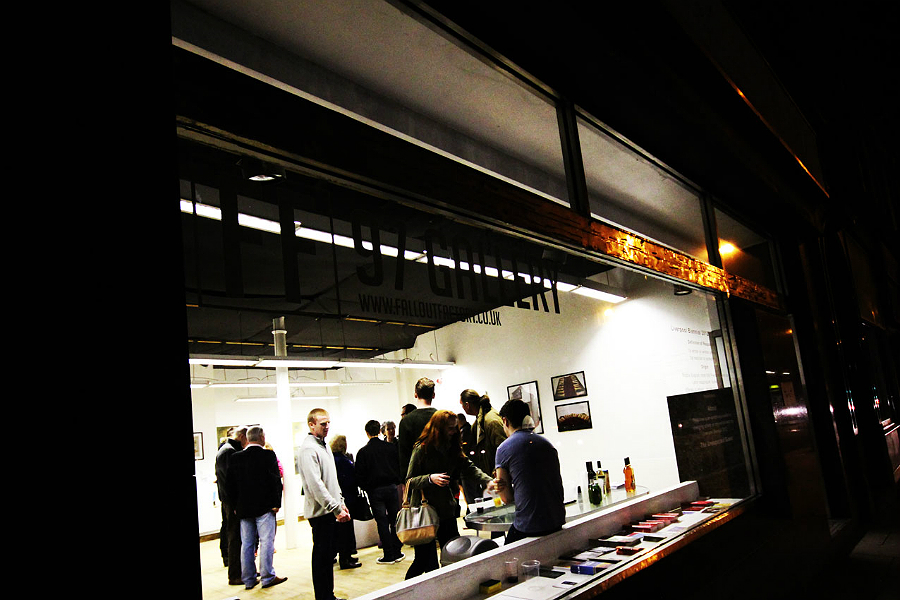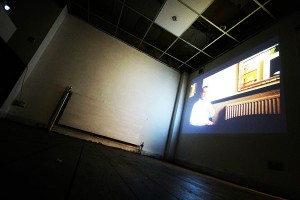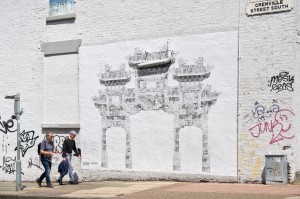Response @ Fallout Factory – Reviewed

Adam Scovell finds reasons to be optimistic about the Independents Biennial at Fallout Factory…
There’s a wealth of independent shows and projects around this year’s Liverpool Biennial. With the official festival itself being so large this year, it’s amazing to see how many extra independents are popping up for the festival and also how high the general quality is of the work on show. The Fallout Factory is an artist led space which focuses on emerging talents from across the city within all mediums and has a clean cut, modern space on Dale Street.
Response isn’t just a tie in to the Biennial’s overall theme: countering the hospitality theme, it looks instead at the viewers who wouldn’t normally question their place in society,with allusions to censorship, class and governed freedom.
Corey Bartle-Sanderson’s untitled work is the most obvious in considering these aspects. The photography shows two different subjects with their faces covered, alluding to the rights of the individual but cutting their freedom away by likening their defining features to their backgrounds. Though not the most subtle of works, looking at censorship will of course create knee-jerk reactions – Bartle-Sanderson’s disgust at the practice clear.
The centre-piece of the space was Viktorija Grigorjevaite’s untitled work, which oddly acted as a collecting point for visitors. Housed in a museum-like glass case, a realistic, miniature corpse appears to be rotting away as guests sip their wine around it. It bears more than a fleeting resemblance to a Victorian sideshow, missing only a fake tail to imply that it’s the corpse of a mermaid. The work is well executed and examines our take on death while looking at the acceptance of it as an unexpected guest in its own right. Whether it’s a welcome one is again an aspect questioned but one that is left hanging in the realms of ambiguity.
The gothica and Victoriana continues in one of the two pieces on show by Georgina Wright, whose photography of animal’s internal organs and limbs seems morbid yet endlessly fascinating. Again the dark veneer found when scratching the surface of the curious Victorian can be found in the work which delights in the macabre. The subjects will forever be poised on that point of grotesque thanks to the capturing of the moment, almost like a polar opposite to Damien Hirst’s A Thousand Years, but significantly more subtle in its execution.
Wright’s other work ties in more with the overall theme and is just as interesting; appearing visually random, with paint and pencil seeming to have had complete freedom in the most Pollock of senses. However, housed next to it is the device used to create the work, which shows a rigid lack of freedom given to the instruments, acting as a dark metaphor for society and its perception of freedom. It sparks off so many uneasy ideas that it is by far the best piece in the show.

In a purely visual sense, the most pleasing work is Rachel Marsh’s trilogy of collages. Said to be based around urban planning and the movement of people, this seems to have acted as a springboard for some colourful explorations of shape and shade, similar to Sinta Tantra’s Together Yet Forever Apart which currently brightens up the outside of Open Eye Gallery. The difference is of course that Marsh’s work is in a gallery context: while looking great in frames, there’s no doubt that it could bear being blown up to a monumental scale.
Not all the work in the exhibition is of this standard. Video installations are so difficult to get right, and while Julia Hare’s work does have a ghostly, eerie feel, it’s hard to differentiate from its equally eerie space making it a strain to imagine it working in a brighter area. Aimee Johnston’s video piece on the other hand is different in that it lacks any sort of visual flavour despite its interviews being interesting.
The only aspect of the show that does bring forth some criticism is its case of “Untitled” syndrome. Whether this is down to a lack of confidence or too much of it, eleven out of the twelve works are untitled and it seems silly that such fine work has failed to garner a title when the artists have displayed such creative ingenuity within their own practices. Of course these are no doubt creative choices but it would be refreshing to see less of it as it is increasingly becoming the norm.
It’s a minor quibble in an otherwise great exhibition. Response is aptly named in its discourse on the theme of this year’s Biennial and instead of just mindlessly copying it, it has found new routes to explore, and raised some dark but interesting questions on the theme and on society as a whole.
Adam Scovell





